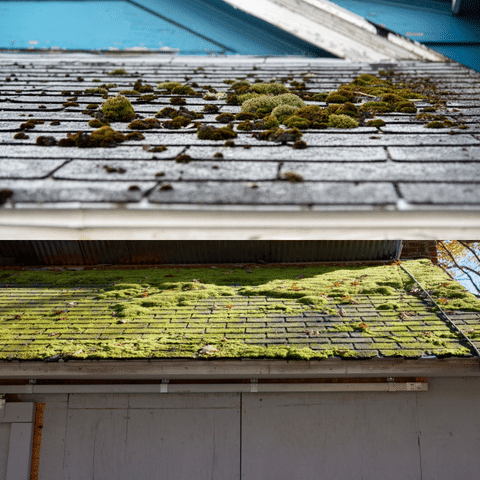The Serious Threat of Moss on Roofs
There are many roofing issues, some more important than others, and some requiring more attention. But the biggest threat of them all is the issues that are downplayed and end up coming around to be the ultimate destroyer.
Moss growth on roofs often goes unnoticed for long periods of time. When homeowners finally notice moss growth, it often appears harmless or minimal, but this perception can be deceiving. Moss has proven to be a serious threat to roofs and is responsible for structural damage to roofs and homes.
To start, a lot needs to be understood about moss growth on roofs and the impact it has before determining any next steps to handle such issues.
What is Moss?
Moss is a flowerless plant that doesn't have roots, but has stems and leaves. It forms from spores, similar to fungi, that are spread by wind into the air and land on damp, moist, and shady surfaces. Moss grows rapidly in these wet, humid environments, and debris can trap the moisture to further increase its growth rate.
Some roofs are ideal environments for moss growth as they can stay damp longer and are in shaded areas, which are conditions prone to moss growth and reproduction.
Moss Damage on Roofs
Moisture buildup leads to roof shingle deterioration and damage. It also increases the likelihood of wood rot, worsening materials, and water leaking through the roofing system and into your home.
Other possible outcomes of moss damage on roofs include:
- Protective layers and oils of shingles becoming stripped, increasing vulnerability to structural damage
- A lack of protection that increases the probability of UV radiation damage
- Pushing shingles apart or causing them to detach; occurs when moss grows and expands underneath shingles
- Blocking drainage or gutter systems, preventing proper water flow
- Bacteria or mold growth
- Rotting structures or underlayment
While a viable option is to remove or wash off moss sitting on an old roof, this may result in shingle damage and diminish the lifespan of the roof. A roof replacement may not be immediately necessary, but there are notable signs to look out for.
- Leaking roof
- Cracked shingles
- Curling or buckling shingles
- Sagging roof
- Granule loss
- Rotting or discolored roof decking in the attic
Next Steps
The first step in dealing with moss growth on roofs is to simply remove it. Doing so will get rid of the main source of problems: moisture buildup. It also removes the moss’s weight from overloading the roof, which causes sagging or leaking if enough moss is built up.
It is also recommended to take immediate steps in doing what’s necessary to prevent further moss growth in the future. This includes:
- Removing shade elements and allowing more sunlight onto the roof, such as trimming trees
- Consistently clearing leaves, twigs, and other debris from the roof and gutters
- Improving the water drainage of the roof and gutter system to prevent moisture or water buildup
- Using solutions that deter moss growth in vulnerable areas
Moss removal is recommended to be taken up by a professional due to safety and owning the necessary materials to properly remove, clean, and minimize damage.
Consider hiring Klaus Roofing Systems of Oregon to inspect the situation and determine whether or not the roof needs a replacement. While it is possible to remove all the built-up moss, debris, and other articles that may have formed or accumulated on the roof, hazardous chemicals and additional damages may be present and necessary for further evaluation.
Klaus Roofing Systems of Oregon offers free estimates on home evaluations, whether the home is in need of moss removal, a roof replacement, or a further inspection into the situation. Call 1-541-485-8199 to learn more.


